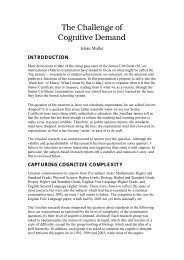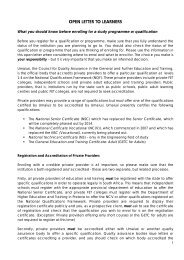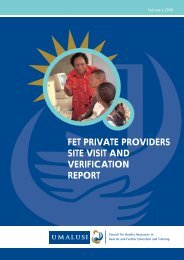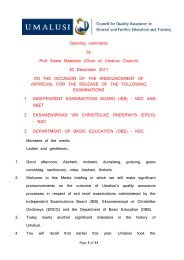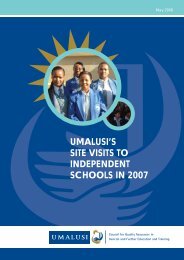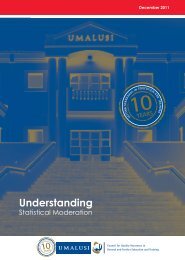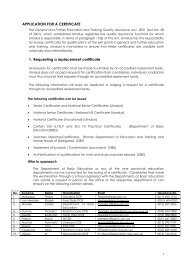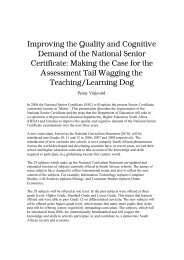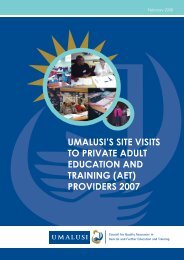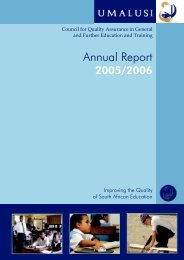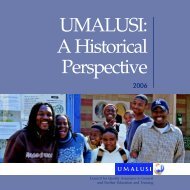Inspecting the Foundations - Umalusi
Inspecting the Foundations - Umalusi
Inspecting the Foundations - Umalusi
Create successful ePaper yourself
Turn your PDF publications into a flip-book with our unique Google optimized e-Paper software.
• Communicating effectively using visual, ma<strong>the</strong>matical and/or language skills in <strong>the</strong> modesof oral/written persuasion.• Using science and technology effectively and critically, showing responsibility towards <strong>the</strong>environment and health of o<strong>the</strong>rs.• Demonstrating and understanding of <strong>the</strong> world as a set of related systems by recognisingthat problem-solving contexts do not exist in isolation.Learning programmes directed towards this qualifi cation will also contribute to <strong>the</strong> fullpersonal development of each learner and <strong>the</strong> social and economic development of <strong>the</strong>society at large, by making individuals aware of <strong>the</strong> importance of:• Refl ecting on and exploring a variety of strategies to learn more effectively.• Participating as responsible citizens in <strong>the</strong> life of local, national and global communities.• Being culturally and aes<strong>the</strong>tically sensitive across a range of social contexts.• Exploring education and career opportunities; and developing entrepreneurialopportunities.ASSOCIATED ASSESSMENT CRITERIA• Associated Assessment Criteria for Exit Level Outcome 1:1.1 Speaking/signing and listening strategies are used to communicate confi dently for avariety of purposes and contexts.1.2 Language conventions and structures are used and responded to in order to conveymeaning and understanding in a variety of contexts.1.3 A variety of learning strategies are identifi ed and used to access and conveyinformation.1.4 A variety of texts are read/viewed and responded to by showing critical awareness tounderstand <strong>the</strong> purpose, <strong>the</strong>mes and contexts.1.5 Independent reading, both aloud and silent, are engaged in for a variety of purposes.• Range: Contexts can include information and pleasure.1.6 A range of texts are explored, planned and drafted to refl ect ideas, facts, opinions,different purposes, audiences and contexts in a creative, expressive or imaginative way.1.7 Grammar and language conventions are understood and used to organise texts in alogical and coherent manner as well as explained and analysed in terms of form andfunction.1.8 Oral language skills are used to explain ideas in a sequenced way across a range oftransactional situations.• Range: Transactional situations include requests, apologies, role-players and stating point ofview.1.8 Non-verbal strategies are identifi ed and discussed in terms of <strong>the</strong>ir infl uence on <strong>the</strong>listener.1.9 Interaction skills are demonstrated by participating in group discussions, debates,conversations, group interviews and surveys.1.10 A critical awareness and use of language style is developed in order to applyappropriately.Associated Assessment Criteria for Exit Level Outcome 2:2.1 Ma<strong>the</strong>matical models are analysed and explained to determine trends and patterns.• Range: Ma<strong>the</strong>matical models include graphs, tables, etc.2.2 Geometric shapes, fi gures and solids are identifi ed and analysed to determine patterns,properties and relationships.• Range: Properties include congruence, straight-line geometry, perspective andtransformations.• Range: Geometric fi gures include regular and irregular polygons and polyhedra, spheres,cylinders.64



